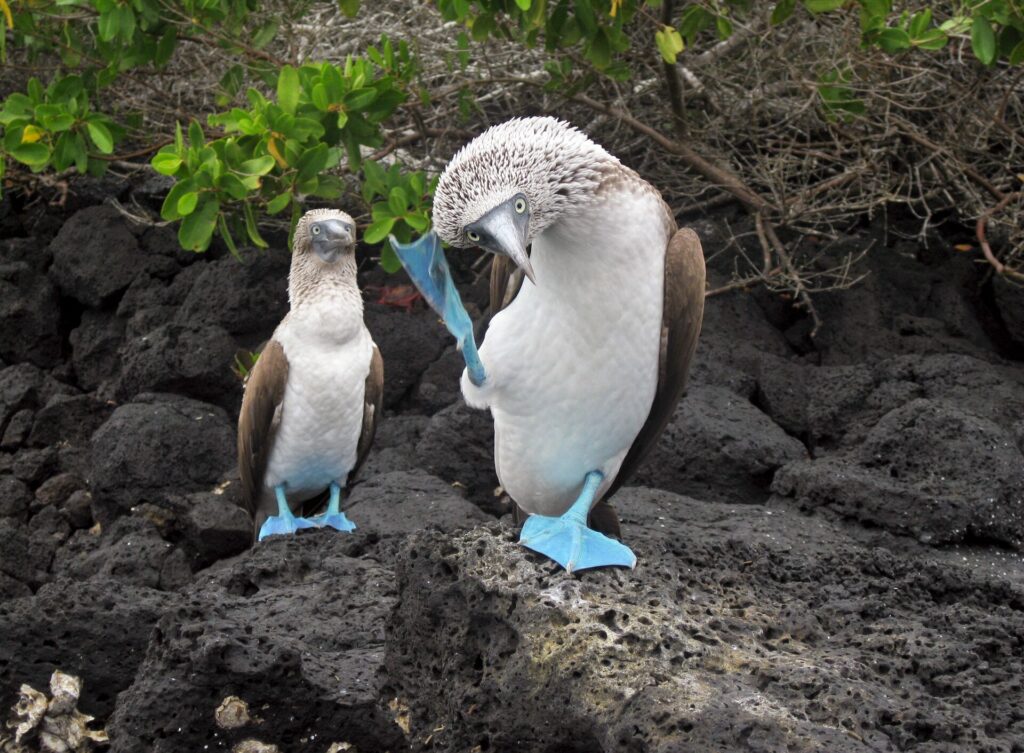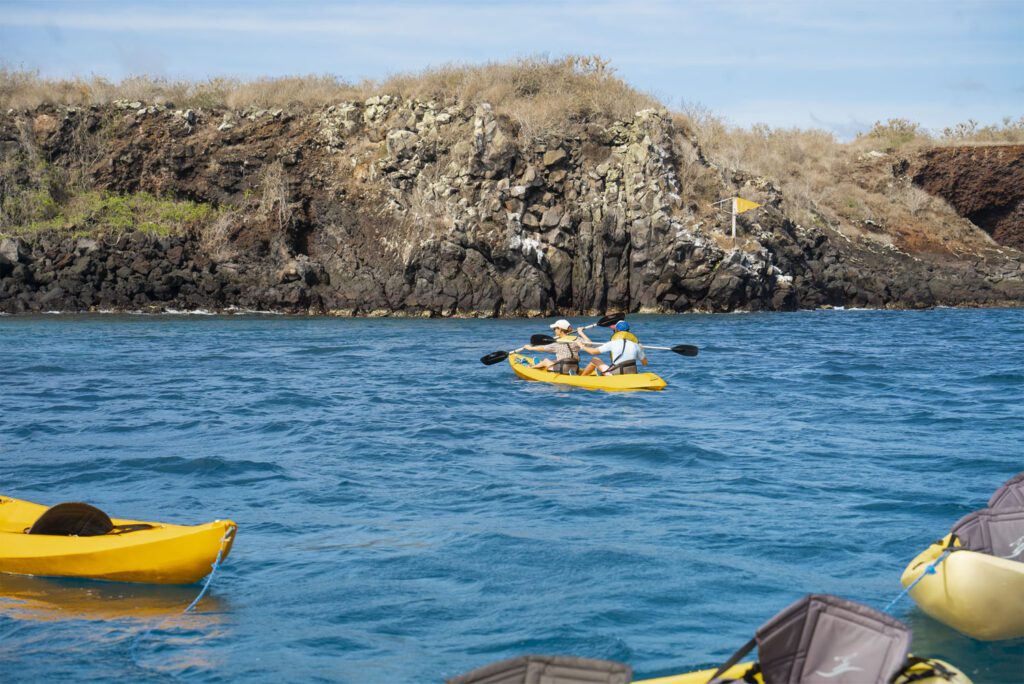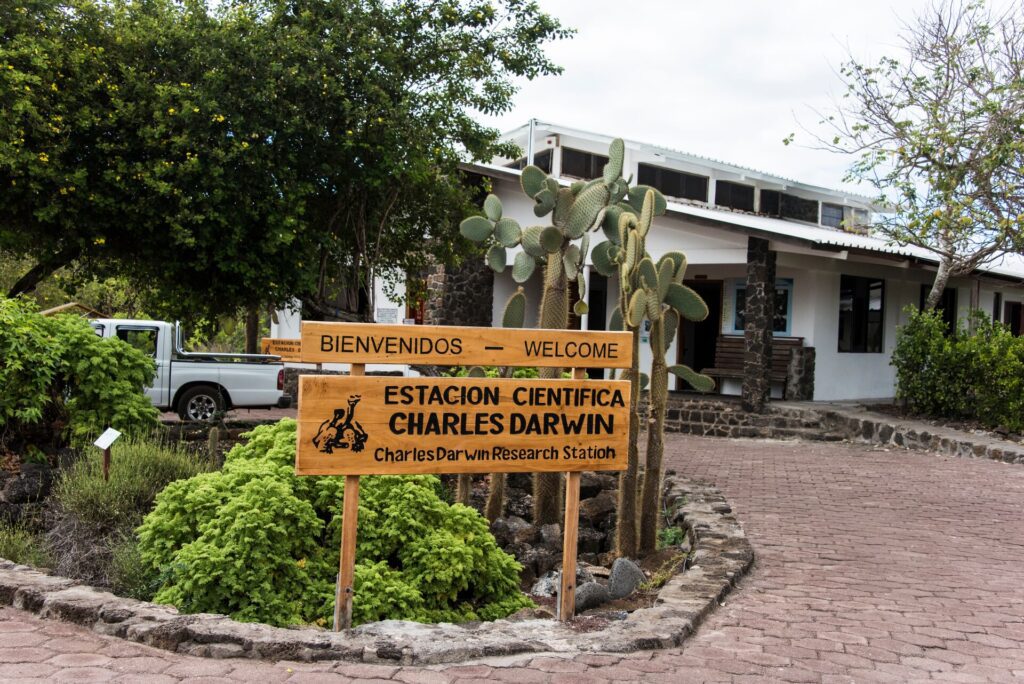Recently updated on May 8th, 2025 at 04:42 am
Scattered over 60,000km² off the coast of Ecuador, the Galápagos Islands are home to such unique ecosystems they inspired Charles Darwin’s Theory of Evolution. This iconic marine wilderness consists of hundreds of small islets and 13 major islands, with the most popular being Santa Cruz, Isabela, San Cristóbal, Santa Fe, Española, Santiago, Floreana, Genovesa and Fernandina. Get your bearings with this handy map.
As this vast archipelago is near the equator, the climate is fairly consistent. And although there are two main seasons – December to May is the hot and rainy season, while June to November is the cooler, dry season – the islands can be enjoyed all year round. Here’s what to expect temperature-wise:
Month | Air | Sea | Weather overview |
January | 25-31°C | 26°C | Warm and humid, occasional rain |
February | 25-31°C | 26°C | Warm and rainy |
March | 25-31°C | 26°C | Hot and humid, light showers |
April | 25-30°C | 27°C | Slightly drier, warm and pleasant |
May | 24-30°C | 27°C | Dry, cooler, and a little breezy |
June | 23-29°C | 25°C | Cooler and drier, breezy |
July | 22-28°C | 25°C | Cool, breezy and dry |
August | 22-28°C | 24°C | Dry and cooler, high winds |
September | 22-27°C | 24°C | Cool, low rainfall, calm weather |
October | 23-28°C | 25°C | Slightly warmer, low rainfall |
November | 24-30°C | 26°C | Warm and dry, calm sea conditions |
December | 25-31°C | 26°C | Warm, light rain and calm seas |
Whenever you visit this World Heritage-listed region, you’ll experience extraordinary wildlife sightings, walk among still-forming volcanic landscapes and enjoy every outdoor adventure under the Ecuadorian sun. Here are 20 unmissable highlights to level up your Galápagos holiday.


Must-see natural wonders
With their lava flows and tubes, vast craters, and active volcanoes, the Galápagos Islands tell the ongoing story of Earth’s evolution, of geology in flux. And while you’ll find epic panoramas wherever you venture, you won’t want to miss these…
1. Bartolomé Island – Iconic viewpoints & volcanic landscapes
Off Santiago Island and covering just over a square kilometre, Bartolomé Island is one of the Galápagos’ most recognisable landmarks thanks to its striking geological feature, Pinnacle Rock: a volcanic plug that towers over the ocean. A short, steep, but rewarding hike takes you to the island’s highest point and back in about 45 minutes, winding through lava formations for expansive views over Bartolomé and its surroundings.
2. Tortuga Bay – A stunning beach & epic marine life
A 40-minute walk from the Puerto Ayora dock on Santa Cruz Island, this 1.5 km beach feels raw, remote, and teeming with life. Turquoise waters, a white-sand beach, and mangroves set the scene for memorable wildlife watching. Nesting sea turtles, rays, marine iguanas, sea lions, flamingos, herons, and Sally Lightfoot crabs are among the most regularly sighted creatures here.
3. Las Grietas – Swim in a natural lava crack lagoon
Also, less than an hour’s hike from Puerto Ayora, Las Grietas is a narrow, saltwater swimming hole wedged between volcanic cliffs, formed when lava flowed through the area and eroded the rocks to create deep fissures. Flanked by imposing rock walls, the lagoon is a peaceful and protected place to float on your back and look up for the soaring frigatebirds that frequent the area.
4. Sierra Negra Volcano – Hike one of the world’s largest craters
With its colossal 10 km diameter, Isabela’s Sierra Negra shield volcano was last active in 2018, making it an awe-inspiring location to experience the raw power of nature. If you’re up for a strenuous four to six-hour trek, stretch your legs on the 12 km hiking trail to the crater’s rim, where every step is rewarded with spectacular views of the caldera and beyond.
Spend five incredible days exploring aboard MV Galápagos Legend, which partners with local conservation organisations to Make Travel Matter.


Best wildlife encounters
The islands’ diverse ecosystems support some 9,000 species, many of them endemic. For the most part, the animals have very little fear of humans, so there are strict wildlife interaction rules to protect them. Only officially authorised guides can lead tours, while visitors must always stay on designated paths, maintain a distance of at least 2 metres from animals and never touch, feed or disturb them. Learn more about Galápagos do’s and don’ts here.
5. Spot blue-footed boobies & frigatebirds
For twitchers, the archipelago has 180 bird species to tick off the list – including the coveted blue-footed booby, which gets its turquoise trotters from the nutrients in its fish-rich diet and is particularly abundant around North Seymour, Isabela, and Santa Cruz. Frigatebirds, known for their distinctive red throat pouches (also known as gulars), are another highlight, often spotted soaring over Genovesa, North Seymour, and Floreana. Galápagos penguins, finches, and flightless cormorants are also must-sees.
6. Visit a giant tortoise reserve
Of all the islands’ creatures great and small, few are as revered as their endangered namesake, the Galápagos giant tortoise – and there are at least 25,000 of them across the archipelago. Visiting El Chato on Santa Cruz is an engaging way to Make Travel Matter and support their conservation. Located in the highlands near Puerto Ayora, the reserve is home to approximately 200 tortoises that thrive and roam freely in a lush, forested environment.
7. Snorkel with sea lions, sharks, and turtles
Encounters with sea lions are an unexpected highlight for many visitors. Numbering around 50,000, they’re the most abundant marine mammal in the area, and you’ll often see them sleeping on the beaches, swimming close to shore, and approaching snorkellers like playful puppies. Snorkelling with placid hammerheads, whitetip reef sharks, and green sea turtles is also a highlight, with San Cristóbal’s Devil’s Crown and Kicker Rock, and Wolf and Darwin Islands all offering excellent opportunities.
8. See marine iguanas up close
The only lizards that have adapted to ocean life, Galápagos marine iguanas dive into the shallows to tuck into ocean algae, so you may see them while snorkelling. The best places to do that are off Isabela, Fernandina, and Santa Cruz; it’s worth noting that those found on Isabela and Fernandina are larger and have unique colour variations.
Searching for a Galápagos holiday deal? Book any Adventure World South or Central American itinerary by 31 May 2025 to save AU$500/NZ$550 per couple. Call our Destination Experts on 1300 363 055 in Australia or 0800 238 368 in New Zealand or for details.


Adventure & outdoor activities
Active experiences bring surprising perspectives to deepen your Galápagos immersion.
9. Kayak or paddleboard along the coast
With so many picturesque islands and islets flanked by calm, clear waters that remain balmy year-round, paddling in the Galápagos is epic. Many cruises host their own expert-guided kayaking and paddleboarding excursions, which takes the guesswork out of understanding each area’s (very variable) currents. While there are countless locations to explore, keep an eye out for Sombrero Chino – where you can paddleboard or kayak around a large conical rock formation under the watchful gaze of sea lions, penguins, Galápagos hawks and marine iguanas – as well as Gardner Bay, Tortuga Bay, and Floreana.
10. Surf at San Cristóbal or Isabela Island
San Cristóbal and Isabela are two of the best places in the world to surf, with uncrowded breaks, consistent waves and beautifully distracting landscapes. On San Cristóbal, Tongo Reef and La Lobería have ideal conditions for beginners, while the bigger swells of Manglecito and Punta Carola are magnets for the more advanced. On Isabela, El Muelle and Punta de Albemarle cater to intermediate and experienced board-riders, with powerful, consistently sizeable waves from December to May.
11. Scuba dive at Kicker Rock and Gordon Rocks
Both sites offer exceptional diving and stellar encounters with some of the Galápagos’ 400-plus marine species. Kicker Rock lies off San Cristóbal, and its underwater topography features deep channels, lava formations, narrow passages, steep walls, and arches. Even though there are strong currents, the visibility is outstanding for up to 30m, and the area is known for its sharks, rays, turtles and colourful fish. Meanwhile, Santa Cruz’s Gordon Rocks site is renowned for its large schools of hammerheads and, if you’re lucky, also whale sharks from June to November.
12. Explore lava tunnels on Santa Cruz
Back on Santa Cruz’s terra firma, a network of lava tubes invites you to literally step inside the island’s evolution, particularly in the highlands near Santa Rosa and El Chato. These geological wonders formed when molten lava continued to flow beneath the cooling surface, creating tunnels tall and wide enough to walk through. Some lava tubes are also open for guided tours, with one of the most accessible being the Tunnel de Lava.
Set sail through the central Galápagos aboard the luxury catamaran, Endemic.


Cultural & local experiences
While the spotlight shines brightest on the natural attractions, the islands have a permanent population of around 33,000 people, so there are plenty of opportunities to meet the locals and learn more about their home.
13. Visit the Charles Darwin Research Station
Near Puerto Ayora, this lauded scientific facility is a fascinating spot to Make Travel Matter by delving deeper into the Galápagos’ natural history, local conservation efforts, and the islands’ sustainable management. Preserving the giant tortoise is one of its key objectives, so it’s also a good place to discover its pioneering breeding and rehabilitation program. The station also has a botanical garden and highlights the key species that informed Darwin’s theory of natural selection.
14. Stroll through the Puerto Ayora fish market
Open from around 6am each day on Santa Cruz, the Puerto Ayora fish market is a hive of activity as local fishermen peddle their freshly caught tuna, mackerel, snapper, sea bass, and lobster, reflecting the archipelago’s rich marine biodiversity. After wandering around and soaking up the buzz (and keeping an eye out for the sea lions, iguanas and pelicans angling for freebies), you can taste their wares at casual restaurants within walking distance of the market.
15. Try freshly caught seafood & local specialties
Whether you’re dining near the Puerto Ayora Fish Market or in standout Isabela restaurants like Maestro De Casa, El Cafetal and Gracias Madre Galápagos, the islands serve a smorgasbord of authentic dining options. Don’t miss signature local dishes like ceviche (fresh fish marinated in citrus); encocado de pescado (coconut fish stew); encebollado (fish and onion stew); arroz marinero (seafood rice); seco (stew of goat, chicken, lamb or beef), or lobster served grilled or stewed.
16. Explore local towns & experience island life
If you’re cruising, the main port towns you’ll visit are Puerto Ayora (Santa Cruz Island), Puerto Baquerizo Moreno (San Cristóbal Island), and Puerto Villamil (Isabela Island). Each has its own appeal: lively Puerto Ayora is the gateway to giant tortoise experiences, lava tube walks and the Charles Darwin Research Station. Laid-back Puerto Baquerizo Moreno is the archipelago’s capital and home to the San Cristóbal Interpretation Centre, where you can delve deeper into the natural history, Darwin’s discoveries, and local Indigenous cultures. Further afield, Puerto Villamil is relaxed and remote with sandy beaches, flamingo-filled lagoons and impressive eateries.
Explore Ecuador’s capital, Quito, then cruise the Galápagos Islands aboard the eco-friendly catamaran, MC Treasure.


Unique & off-the-beaten-path destinations
Just being in the Galápagos is probably enough to make you feel completely removed from the everyday – after all, it’s not every day you’re 1000km off the coast of Ecuador in the eastern Pacific Ocean! But if you’re keen on even lesser-known experiences, add these gems to your itinerary…
17. Walk the historic Wall of Tears
Alternatively known as El Muro de las Lágrimas, this lava-stone wall was built by prisoners forced into labour from 1945-1959, when Isabela Island housed a penal colony. It’s said the wall gets its name from the pain the prisoners experienced when placing each stone by hand, with the conditions so miserable and dangerous that thousands lost their lives. Today, the wall serves as a place to commemorate a dark chapter in the islands’ history, and you can hike along its scenic trail.
18. Discover Los Tuneles on a snorkelling tour
Also on Isabela Island, Los Tuneles is an excellent site to strap on a snorkel and discover surreal underwater scenery, featuring spectacular arches and lava tunnels filled with seahorses, iguanas, penguins, manta rays, turtles, and colourful fish. The site is fairly calm and shallow with great visibility, making it a hit with both experienced snorkellers and beginners.
19. Watch the sunset with sea lions at Playa Lobería
Facing west for scenic sundowners and home to a large population of sea lions, the sandy beach of Playa Lobería (San Cristóbal Island) is a spectacular place to farewell the day and watch these playful pinnipeds haul out. Plus, it’s just 15 minutes from Puerto Baquerizo Moreno.
20. Explore the remote Española Island
The archipelago’s oldest and southernmost island is known for its Española land iguanas, colourful marine iguanas, Galápagos hawks, and waved albatrosses. For a closer look at these critically endangered beauties, as well as the island’s lava fields, diverse ecosystems and blowhole, lace up your hiking boots for the 2.5 km Punta Suarez trail.
Venture deep into the southeastern Galápagos aboard the luxe expedition yacht, La Pinta.


Your frequently asked Galápagos Islands questions, answered
Three things to know before you go…
Can you explore independently?
Yes, you can explore the Galápagos independently, but there are restrictions and permit requirements. All visitors must pay a National Park entrance fee, and certain activities, like diving or visiting restricted islands, may require additional special permits or licensed guides. The main advantage of travelling independently is that you can create your own schedule, but as some islands and activities are only accessible via authorised cruises and guided tours, you might not be able to do everything on your wish list. For details, visit the official Galápagos National Park website.
What’s better, cruising by catamaran or on a small expedition ship cruise?
Both have their advantages. Cruising by catamaran is intimate with just 10-20 passengers, there’s a little more flexibility, and you can access places larger vessels can’t reach. By comparison, small expedition ships carry up to 200 passengers, so you’ll meet like-minded passengers and access a broader range of onboard amenities, such as spas, gyms and lounges.
How many days should you spend in the Galápagos?
For a well-rounded Galápagos experience, plan for at least five days, but if possible, aim for a week or two. A five-day trip will cover the central islands like Santa Cruz and Santiago, while seven to 14 days will get you out to the more remote spots like Floreana, Española and San Cristóbal.
